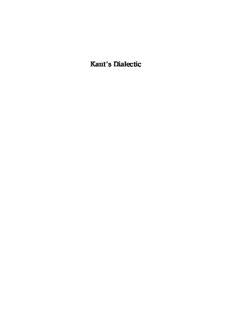
Kant’s Dialectic PDF
Preview Kant’s Dialectic
Kant’s Dialectic Kant’s Dialectic B jonathan bennett UniversityPrintingHouse,CambridgeCB28BS,UnitedKingdom CambridgeUniversityPressispartoftheUniversityofCambridge. ItfurtherstheUniversity’smissionbydisseminatingknowledgeinthepursuitof education,learningandresearchatthehighestinternationallevelsofexcellence. www.cambridge.org Informationonthistitle:www.cambridge.org/9781316506073 ©CambridgeUniversityPress1974 Thispublicationisincopyright.Subjecttostatutoryexception andtotheprovisionsofrelevantcollectivelicensingagreements, noreproductionofanypartmaytakeplacewithoutthewritten permissionofCambridgeUniversityPress. Firstpublished1974 Reprinted1977,1981,1986,1990 Re-issuedinadigitallyprintedversion2009 CambridgePhilosophyClassicsedition2016 PrintedintheUnitedKingdombyClays,StIvesplc AcataloguerecordforthispublicationisavailablefromtheBritishLibrary LibraryofCongressCataloginginPublicationdata Names:Bennett,Jonathan,1930–author. Title:Kant’sdialectic/JonathanBennett. Description:NewYork:CambridgeUniversityPress,2016.|Originallypublished: NewYork:CambridgeUniversityPress,1974|Includesbibliographical referencesandindex. Identifiers:LCCN2015048475|ISBN9781107140578(Hardback:alk.paper)| ISBN9781316506073(Paperback:alk.paper) Subjects:LCSH:Kant,Immanuel,1724-1804.|Dialectic. Classification:LCCB2799.D47B42016|DDC193–dc23LCrecordavailableat http://lccn.loc.gov/2015048475 ISBN978-1-107-14057-8Hardback ISBN978-1-316-50607-3Paperback CambridgeUniversityPresshasnoresponsibilityforthepersistenceoraccuracy ofURLsforexternalorthird-partyinternetwebsitesreferredtointhispublication, anddoesnotguaranteethatanycontentonsuchwebsitesis,orwillremain, accurateorappropriate. Preface to this edition karl ameriks B JonathanBennett'sKant'sDialecticisalandmarkworkinmodernscholar- ship.Itsappearancein1974wasoneofthefirstexpressionsofaconfluence of three major trends that for fifty years now have played a major role in philosophy.Thefirsttrendisthegeneralre-emergenceofmetaphysicsasa source of positive attraction for the best and the brightest in the field. A second surprising trend has been the renaissance of studies in the historyofphilosophy.Whereasearlier,historyandphilosophywereoften contrastedastwodifferentfields,ahistoricalturnhasnowtakentheform ofanavalancheofdetailedstudiesofmajormodernfigures(e.g.,Bennett’s Locke,Berkeley,Hume:CentralThemes,1971),aswellasanincorporationof historical considerations directly in the content of significant systematic argumentation. A third trend is the rehabilitation of Kant’s philosophy, and a reconsideration of all aspects of his system as relevant to contem- porary thought. Along with P. F. Strawson and Wilfrid Sellars, Jonathan Bennett was a prime analytic instigator of this movement already in the 1960s,withhis firstbookonKant,Kant’sAnalytic(1966).Thisbookmade Bennettfamousasa practitionerofanapproachthat favoursreconstruct- ingaconciseandinterestingformofargumentthatseemstobepresentin the text, and then not hesitating to mercilessly expose its apparent short- comings,allforthepurposeofleadingtomoresatisfactoryargumentson the important topics under discussion. Kant’s Dialectic employs a some- what similar approach but expresses a broader perspective, one enriched with considerably more historical detail and reference to relevant prede- cessors.Afteranextremelyhelpfulreview,inthefirstthreechapters,ofthe general themes of the ‘Analytic’, that is, the first major section of Kant’s Critique of Pure Reason, Kant’s Dialectic launches into a path-breaking and detailed treatment of the key metaphysical terms of the second major section of the Critique: substantiality, simplicity, identity, infinity, limits, divisibility, freedom, God, and reason. The mere fact that this part of Kant’stext–whichhadforsolongbeenignoredbecauseofitsseemingly old-fashioned themes: rational psychology, cosmology, theology – received such careful attention by Bennett was already a revolution in its time.Thecontentoftheattentionisevenmoreremarkable,andtheissues ix x prefacetothisedition that areraised,about matterssuch as ‘quasi-memory’,relations,vacuum, agency,andregulativeprinciples,remainjustascentralinleadingworkin currentphilosophy. Bennett’sdiscussion is especiallyvaluable because of hisin-depthunderstandingofLeibniz’srelevance(seehisnewCambridge edition of Leibniz’s New Essays on Human Understanding). Among the many highlights of the book, especially for advanced students, is the discussionof‘inflatingthefirstparalogism’(section25),ofthe‘weakening move’ (section 45) in consideration of the antinomies of the infinite, and thecomplexitiesof‘realdivisibility’(section54).Thereisnobetterwayto prepareoneselfforaseriouscontemporarystudyofthecentralconceptsof Kant’s Dialectic than by working through every page of Bennett’s still invaluable commentary. Contents B Preface to this edition bykarl ameriks page ix Preface xi System of references xiii 1 Introduction 1 1 Locatingthesubject-matter 1 2 Themaintopics 4 3 Backgroundmaterials 5 2 Concepts and intuitions 9 4 Thesensory/intellectualcontinuum 9 5 Troublefromthecontinuum 12 6 Kant’sbreakthrough 16 7 Contentv.activity 20 8 Conceptsandjudgments 23 9 Concept-empiricism 26 10 Thetheoryofcategories 30 11 Categoriesand‘innateideas’ 35 3 Substances and reality 40 12 Substancesandaggregates 40 13 Cartesiansubstances 42 14 Leibnizonsubstancesandreality 44 15 Leibnizonrelationsandreality 46 16 Kantonreality 49 17 Thingsinthemselves 52 18 Impositionandthingsinthemselves 54 19 Substancesassempiternal 56 20 Thebalanceprinciple 60 21 Existence-changesandquantifiers 62 4 The substantiality of the soul 66 22 TheCartesianbasis 66 23 Thesearchforthethinkingsubject 69 24 Thesoulassubstance 72 v vi contents 25 Inflatingthefirstparalogism 76 26 Mydeath 78 5 The simplicityof the soul 82 27 Thesoulassimple 82 28 Mentalfission 85 29 Mentaldisunity 87 30 Simplicityandimmateriality 90 6 The identity of the soul 94 31 Thethirdparalogism:blindalleys 94 32 Locatingthethirdparalogism 96 33 Quasi-memory 98 34 Kant’sobserver 101 35 Identityandsubstrata 104 36 Substrata:twosources 107 37 Substrata:fourconsequences 109 38 Strawsonontheparalogisms 112 7 Infinity 115 39 Theantinomieschapter 115 40 Thelimitsoftheworld 118 41 Infinitetasks 122 42 Thefuturizingmove 124 43 Infinitenumber 127 44 Numbersandnaturalnumbers 130 45 Theweakeningmove 133 46 Infiniteandindefinite 139 8 Limits 145 47 Leibnizonspace 145 48 Leibnizonvacuum 148 49 Whytheworldisnotfinite 154 50 Otherarguments 157 51 Whytheworlddidnotbegin 161 9 Divisibility 165 52 Simplesubstances 165 53 Thedivisibilityoftheextended 166 54 Realdivisibility 170 55 Kantagainstatomism 172 56 Substanceandsubstances 176 57 Thesupposedinfinityproblem 179 58 Thedivisibilityofspace 183 contents vii 10 Freedom 186 59 Thethirdantinomy 186 60 Fromcosmologytohumanity 189 61 Theskeletonofatheory 192 62 Areconciliation? 195 63 HumeandSchlick 197 64 Restrictingdeterminism 201 65 Whendoesfreedomoccur? 203 66 Reactiveattitudes 207 67 Kantandreactivity 211 68 Agency 213 69 Self-prediction 217 70 Kantandagency 221 71 ExcusesforKant’stheory 225 11 God 230 72 TheKant–Fregeview 230 73 Existenceandnecessaryexistence 234 74 WhyMalcolm’sargumentfails 237 75 Aquinas’sthirdway 240 76 Thefourthantinomy 242 77 Thecosmologicalargument 246 78 Thesecondstep 250 79 Kant’sattack 253 80 Theradicalcriticism 255 81 Theargumentfromdesign 257 12 Reason 261 82 Inferencesofreason 261 83 Ascendingreason 263 84 Conditions 267 85 Thesourceofdialecticalerror 270 86 Regulativeprinciples 273 87 Arethereanyregulativeprinciples? 277 88 Regulativeandconstitutive 279 89 ThearchitectonicoftheDialectic 284 90 Reasonandcosmology 287 Index 292
Description: